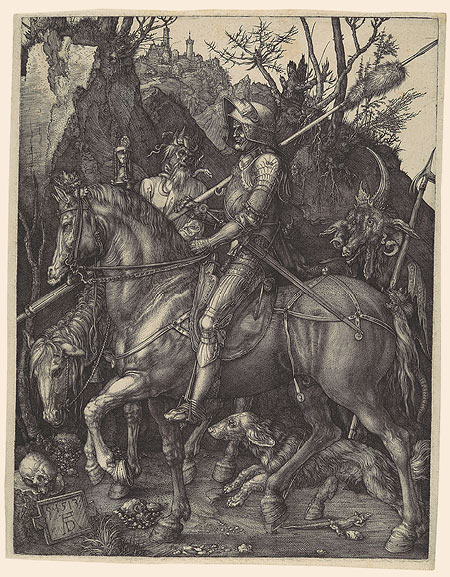The first was titled Ritter, Tod und Teufel (Knight, Death and Devil) (1513). This allegorical piece zoomed in on a weary-looking knight amounting a sturdy steed, accompanied by two goat-like strange creatures, one on an exhausted horse to the knight's right — Death, identifiable by the hourglass in his hand reminding the knight of the shortness of life, and the other one following behind on foot, even more hideous looking than Death — the Devil, joining in hearty taunting. Underneath the knight's horse, a hound resolutely ran along on that narrow range of a waste land, as steadfast as the master, who maintained his proud posture and stony countenance in the company of danger, could be seen either as symbol of courage, or foolhardiness.
Dürer's technical virtuosity was astounding, not only in the tense subject and well-planned composition, but particularly also in many fine details, such as the majestic muscles and shining pelt of the horse, the menacing cliffs pressing on the travelers, and the castles seen through barren branches atop the jagged ridge, all through flowing lines, endlessly varied types of fine hatching, the subtle modulations of light and shadow, and the absolute confidence in rendering of minutiae details.

Albrecht Dürer [Public domain], via Wikimedia Commons
Ritter, Tod und Teufel (Knight, Death and Devil), 1513, Albrecht Dürer, 1471-1528
The second Dürer was Das Meerwunder (The Sea Monster, or The Sea Wonder), ca. 1498. This engraving depicted a naked maiden, lying on the back of a scaled creature with human head and fish body, being led or dragged away from shore into broad water body, though it was curiously narrow, more an estuary than an open sea. The background featured a steep hill and a castle on top, and a grander castle at the foot of the hill, just above the shore, onto which maidens clambered several naked in great haste, ostensibly fleeing from danger, the sea monster, and nearby, an old man gesticulating his alarm, next to a collapsed woman lamenting on the ground.
Despite all the drama on the distant shore, the central figures, both the sea creature and the abducted maiden, were rather curiously calm and almost nonchalant save for a few traces of sadness, resignation, and slight distress on the maiden's face, which was in turn betrayed by her body's eloquent pose in a reclined pose often associated with voluptuous and seductive Venus. This contradiction created a fascinating though somewhat sad enigma.
Comparing to the dark tone of Knight piece, this one was much brighter, almost ironically sunny, dominated by more white space due to far less hatching, and result was airy and quite suitable to the sea setting, though no necessarily the obviously disturbing story. These main figures and landscape though were no less three-dimensional, due to energetic and graceful lines, and subtle suggestions of shades and volumes, as in a very fine line drawing.

Das Meerwunder (The Sea Monster, or The Sea Wonder), ca. 1498, Albrecht Dürer
Albrecht Dürer [Public domain], via Wikimedia Commons
My Favorite Museum Collection Series
>> My Favorite Museum Collection Series 148: My Favorite Paintings at Iris & B. Gerald Cantor Center for Visual Arts at Stanford University
<< My Favorite Museum Collection Series 146: My Favorite Artifacts in Phoebe A. Hearst Anthropology Museum, UC Berkeley
List of My Favorite Artworks in the Museums I've Visited
Other Related posts on Art · 文化 · Kunst:
- Crescat Graffiti, Vita Excolatur by Quinn Dombrowski
- My Favorite Paintings at Musée Marmottan Monet
- Museum of Modern Art (MOMA), New York City
- Max Beckmann's Paintings in MOMA and MET
- Gustav Klimt and Egon Schiele in Wien (Vienna)





No comments:
Post a Comment